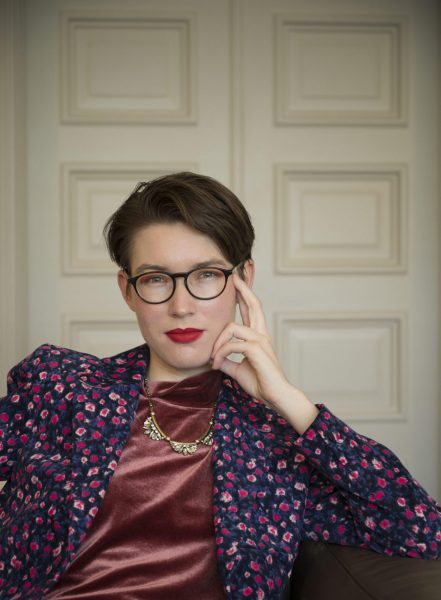
C.E. Janecek: You’ve written multiple poems that are named for mile markers, including “Mile 49—” and “Mile 57—” in the latest issue of Colorado Review. What brought you to these poems? Do you envision them as an expanding series?
Lucien Darjeun Meadows: I’m so glad you asked! These two poems are part of an emerging manuscript that engages place, community, and identity through my running of the Never Summer ultramarathon in Northern Colorado. Across the manuscript, I use the linear mile-marker-based progression of this 64-mile race to open a nonlinear exploration of participating in such a predominantly white, heterosexual, and male sport that’s often focused on dominance and individual glory. Many of the poems work across both the Cherokee and English languages, and more often than not, I’m also shifting across the place of the race (Colorado) and of home (West Virginia and North Carolina).
CEJ: How does walking influence your writing? Do you see yourself as carrying on a tradition of walking poetry?
LDM: Though I’ve spent hours on trails for years, as a hiker, runner, interpreter, and volunteer ranger assistant, it wasn’t until recently that I began to write—directly—about hiking or running. I’m pursuing a PhD in English & Literary Arts, and like the stereotypical “literature major,” most of my must-dos and love-tos involve language. Being and thinking and communicating in language. And yet, language only goes so far. I love to reach a state on the trail where I am no longer existing in language, where I become just one sensory body among other (ecological) sensory bodies—and then, even these bodies become permeable, too. Especially in these Never Summer poems, I’m trying to dwell in that permeable, nonhierarchical space, and doing so while trying to language the moment, the experience, is an exciting challenge. I am grateful to writers who have shown pathways into this important work, like Layli Long Soldier, Ruth Ellen Kocher, Joan Naviyuk Kane, Jennifer Chang, and Dan Beachy-Quick.
CEJ: Your poems blend the narrator’s body and his surroundings: “There was a boy who was a boy who was a tree who was a river and a rock and a cloud . . . Who stood naked in his changing body out in the grapevines and crushed the long black fruit in his hands” (Mile 57—). How do you understand the relationship between queerness and nature in your work?
LDM: Essential and challenging. Heartbreaking and energizing. A continual process of reclamation. As an outdoor interpreter, I often encounter sentiments about how nature is a “great equalizer” that is “open to all,” and how identity “doesn’t matter” on the trails. In a recent NPR interview, Black nonprofit professional Patricia Cameron asks, “What about transportation? How do you get to certain outdoor environments? Do you have the gear to enjoy the outdoors,” and she remarks “Nature isn’t going to call me the N-word, but the people outside might.” Only 6% of visitors to US national parks identified as Black, while 77% identified as white according to a 2018 survey by the National Park Service. And, through naming, professional representation, and visitor representation, Indigenous peoples and histories are often set firmly in the (distant) past, if not erased. Queer folks, also, frequently find themselves outside representations of the (straight, white, male) hiker or outdoor person. I know over one hundred trail runners and have participated in numerous races—and I have yet to see another visibly out and queer couple. It is frightening and draining to continually evaluate whether I can risk saying “my partner” or even “my partner, he,” on a training run, or in a race, whether I can risk a hug at an aid station. In ultrarunning, I’m usually surrounded by straight, white, male runners who—let’s be honest!—almost always outweigh and outrun me; meanwhile, we’re miles if not sometimes hours from the nearest town.
CEJ: Which writers are you influenced by? What books would you recommend to our readers?
LDM: Layli Long Soldier, Ruth Ellen Kocher, Joan Naviyuk Kane, Jennifer Chang, and Dan Beachy-Quick, as writers working in spaces between existence and language. I could live for years with only domina Un/blued (Kocher), Hyperboreal (Kane), and Mulberry (Beachy-Quick) on the bookshelf. Sean Hill, J. Drew Lanham, and Camille T. Dungy, as writers making visible important intersections and biases around race, environment, and nature writing. Black Nature: Four Centuries of African American Nature Poetry, edited by Camille T. Dungy, is incredible. And, for readers who enjoy anthologies, Native Voices: Indigenous American Poetry, Craft and Conversations, edited by CMarie Fuhrman and Dean Rader, is a wonderful introduction and deepening into contemporary Indigenous American poetics. And I’ve recently discovered, and fallen in love with, Kimmy Beach’s ecological dystopian lyric novel Nuala.

C.E. Janecek is a Czech-American writer, poetry MFA student at Colorado State University, and assistant managing editor at Colorado Review. Janecek’s poetry has been featured in Heron Tree, Lammergeier, The Florida Review, Permafrost, and others. Instagram @c.e.writespoems.
Author photo (Meadows) by Erin Bibeau.